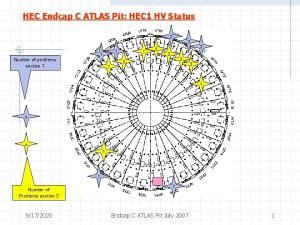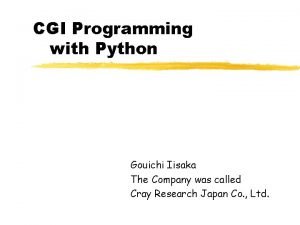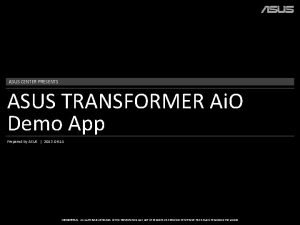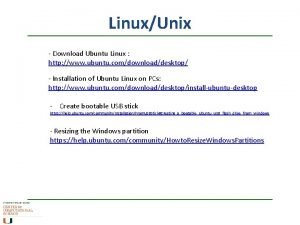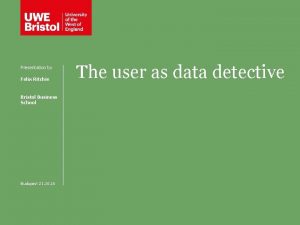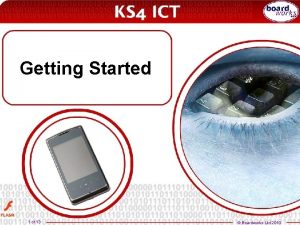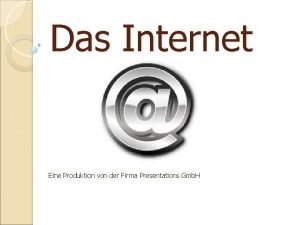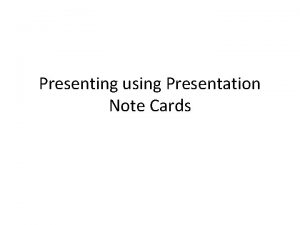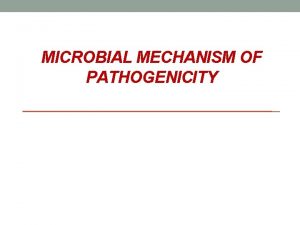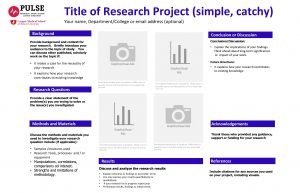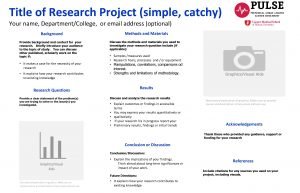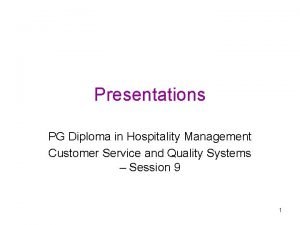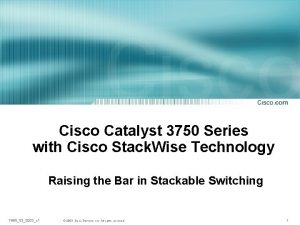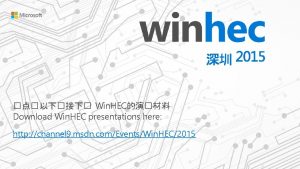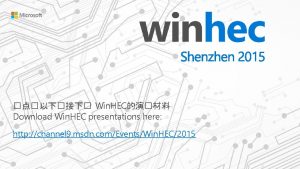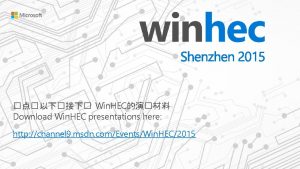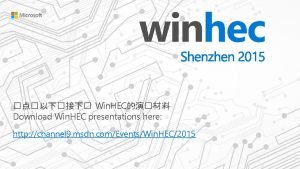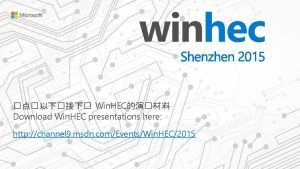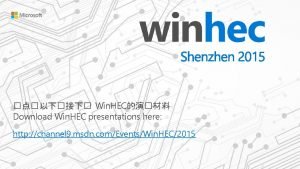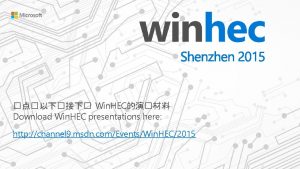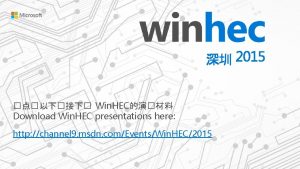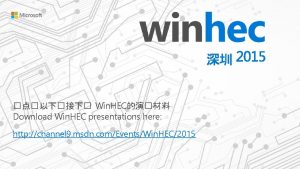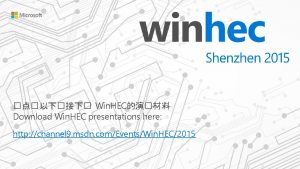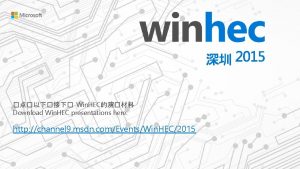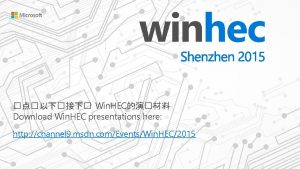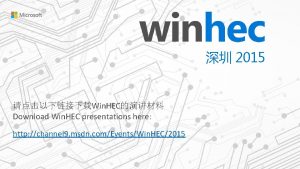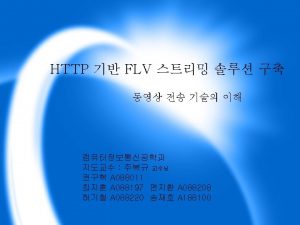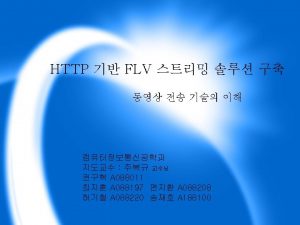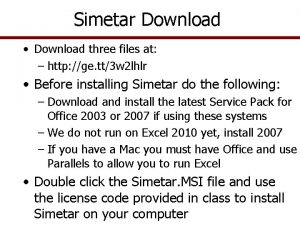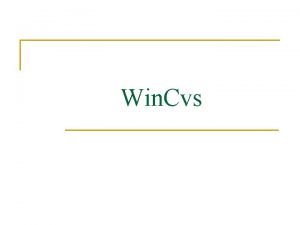Win HEC Download Win HEC presentations here http














![Wdf. Driver. Create ( Raw. Driver. Object, […] , attributes, &driver ) Wdf. Driver. Create ( Raw. Driver. Object, […] , attributes, &driver )](https://slidetodoc.com/presentation_image/21448d8e8e16604ba029cc2a4930bb06/image-15.jpg)
![NTSTATUS Driver. Entry( _In_ PDRIVER_OBJECT Driver. Object, _In_ PUNICODE_STRING Registry. Path ) { […] NTSTATUS Driver. Entry( _In_ PDRIVER_OBJECT Driver. Object, _In_ PUNICODE_STRING Registry. Path ) { […]](https://slidetodoc.com/presentation_image/21448d8e8e16604ba029cc2a4930bb06/image-16.jpg)


































- Slides: 50

�点�以下�接下� Win. HEC的演�材料 Download Win. HEC presentations here: http: //channel 9. msdn. com/Events/Win. HEC/2015









I/O Request handling Driver Initialization Hardware preparation H/W Interaction Pnp/Power Interaction Driver Cleanup

WDFOBJECT Methods Events Properties WDF functions that operate on objects Where you can register callbacks Single values accessible via get/set methods

Driver (WDFDRIVER) Device (WDFDEVICE) … Queue (WDFQUEUE) … Wdf. Request. Complete. With. Information( Request, STATUS_INVALID_DEVICE_REQUEST, (ULONG_PTR) 0 );


I/O Request handling Driver Initialization Hardware preparation H/W Interaction Pnp/Power Interaction Driver Cleanup
![Wdf Driver Create Raw Driver Object attributes driver Wdf. Driver. Create ( Raw. Driver. Object, […] , attributes, &driver )](https://slidetodoc.com/presentation_image/21448d8e8e16604ba029cc2a4930bb06/image-15.jpg)
Wdf. Driver. Create ( Raw. Driver. Object, […] , attributes, &driver )
![NTSTATUS Driver Entry In PDRIVEROBJECT Driver Object In PUNICODESTRING Registry Path NTSTATUS Driver. Entry( _In_ PDRIVER_OBJECT Driver. Object, _In_ PUNICODE_STRING Registry. Path ) { […]](https://slidetodoc.com/presentation_image/21448d8e8e16604ba029cc2a4930bb06/image-16.jpg)
NTSTATUS Driver. Entry( _In_ PDRIVER_OBJECT Driver. Object, _In_ PUNICODE_STRING Registry. Path ) { […] // Create WDF Driver Object WDF_OBJECT_ATTRIBUTES_INIT(&attributes); attributes. Evt. Driver. Unload = On. Driver. Unload; WDF_DRIVER_CONFIG_INIT(&config, On. Device. Add); status = Wdf. Driver. Create(Driver. Object, Registry. Path, &attributes, &config, &driver ); } Declare vars WDF Event WDF Method WDF Object


NTSTATUS On. Device. Add( WDFDRIVER Driver, PWDFDEVICE_INIT Device. Init ) { WDFDEVICE device; IWDFIo. Queue * p. Default. Queue = NULL; Device. Init->Set. Power. Policy. Ownership(TRUE); status = Wdf. Device. Create(&Device. Init, &device. Attributes, &device); context = Get. Context(device); context->Wdf. Device = device; status = p. IWDFDevice->Create. Io. Queue( NULL, TRUE, Wdf. Io. Queue. Dispatch. Parallel, TRUE, FALSE, &p. Default. Queue ); return status; } Static Configuration Device Create Setting Context Queue Create

I/O Request handling Driver Initialization Hardware preparation H/W Interaction Pnp/Power Interaction Driver Cleanup

Get hardware resources, Do some static configuration, (Prepare. Hardware) Enter powered state (D 0 Entry) Enable interrupts (Interrupt. Enable) …

Get hardware resources, Do some static configuration, (Prepare. Hardware) NTSTATUS On. Prepare. Hardware( WDFDEVICE Device, WDFCMRESLIST Resources. Raw, WDFCMRESLIST Resources. Translated ) { int Resource. Count = Wdf. Cm. Resource. List. Get. Count( Resources. Translated ); for (i=0; i < Resource. Count; i++) { Enter powered state (D 0 Entry) descriptor = Wdf. Cm. Resource. List. Get. Descriptor( Resources. Translated, i); switch(descriptor->Type) { case Cm. Resource. Type. Port: […] case Cm. Resource. Type. Memory: […] case Cm. Resource. Type. Interrupt: […] default: break; } Enable interrupts (Interrupt. Enable) … } return STATUS_SUCCESS; }

Get hardware resources, Do some static configuration, (Prepare. Hardware) Enter powered state (D 0 Entry) NTSTATUS On. D 0 Entry( IN WDFDEVICE Device, IN WDF_POWER_DEVICE_STATE Recent. Power. State ){ PADXL 345 Acc. Device p. Acc. Device = nullptr p. Acc. Device = Get. Context(Device); Wdf. Wait. Lock. Acquire(p. Acc. Device->m_Wait. Lock); I 2 CSensor. Write. Register( p. Acc. Device->m_I 2 CIo. Target, MY_REGISTER, MY_VALUE, sizeof(MY_VALUE) ); Enable interrupts (Interrupt. Enable) … p. Acc. Device->m_Powered. On = true; Wdf. Wait. Lock. Release(p. Acc. Device->m_Wait. Lock); return STATUS_SUCCESS; }

Get hardware resources, Do some static configuration, (Prepare. Hardware) NTSTATUS On. Interrupt. Enable( IN WDFINTERRUPT Interrupt, IN WDFDEVICE Device){ PDEVICE_EXTENSION ULONG reg. Ulong; PULONG int. Csr; Enter powered state (D 0 Entry) dev. Ext; dev. Context = Get. Device. Context( Wdf. Interrupt. Get. Device(Interrupt) ); int. Reg. Id = &dev. Context->Int. Register. Id Enable interrupts (Interrupt. Enable) reg. Val = READ_REGISTER_ULONG( int. Reg. Id ); reg. Val = ENABLE_INTERRUPT_BYTE( reg. Val ); WRITE_REGISTER_ULONG( int. Reg. Id, reg. Val ); … return STATUS_SUCCESS; }

Get hardware resources, Do some static configuration, (Prepare. Hardware) Enter powered state (D 0 Entry) Enable interrupts (Interrupt. Enable) …

I/O Request handling Driver Initialization Hardware preparation H/W Interaction Pnp/Power Interaction Driver Cleanup

IRP I/O WDFREQUEST Dispatcher Queue Selection Execution Level & Sync Scope Power Management WDFREQUEST Driver’s On. Read

I/O ead R IRPs I/O Dispatcher Write IOC TL I/O Dispatcher Queue Selection Execution Level & Sync Scope Power Management Parallel WDFREQUEST Sequential WDFREQUEST Manual WDFREQUEST Driver’s On. Read

I/O Dispatcher Queue Selection Execution Level & Sync Scope Power Management Driver’s On. Read IRQL: Interrupt Request Level (PASSIVE_LEVEL, DISPATCH_LEVEL) Execution Level: IRQL at which event callbacks are invoked Synchronization Scope: Mechanism for enforcing serialization of callback execution by managing locks Device Scope: Synchronization of callbacks for a device’s queue and file objects Queue Scope: Synchronization of callbacks for a queue None: No synchronization

I/O Dispatcher Queue Selection Execution Level & Sync Scope Power Management Driver’s On. Read

Wdf. Request. Mark. Cancelable ( Request, On. Request. Cancel );

I/O Request handling Driver Initialization Hardware preparation H/W Interaction Pnp/Power Interaction Driver Cleanup



Wdf. Io. Target. Send. Ioctl. Synchronously( io. Target, NULL, IOCTL_ACPI_ASYNC_EVAL_METHOD, &input. Buf. Desc, &output. Buf. Desc, NULL);

I/O Request handling Driver Initialization Hardware preparation H/W Interaction Pnp/Power Interaction Driver Cleanup




WDF_DEVICE_POWER_POLICY_WAKE_SETTINGS_INIT(&wake. Settings); Wdf. Device. Assign. Sx. Wake. Settings( device, &wake. Settings );

I/O Request handling Driver Initialization Hardware preparation H/W Interaction Pnp/Power Interaction Driver Cleanup


WDF on Git. Hub! Available starting tomorrow Includes KMDF and UMDF v 2 Published under MIT License





Developing Drivers with Windows Driver Foundation Kernel-Mode Driver Framework Design Guide User-Mode Driver Framework Design Guide Choosing a driver model A basic “Toaster” sample (UMDF 2) Echo driver sample, showing queues and IOCTLS (KMDF) USB FX 2 Function Driver (UMDF 2)

Grand Ballroom III 12: 30 Introduction to Hardware Lifecycle 13: 40 Tools for Windows Driver Development 15: 00 Intro to Windows Driver Development 16: 10 Writing Drivers with the WDF Mansion VIII <Day 2> Lab: Getting Started with Driver Dev 10: 30 11: 30 Lunch 12: 30 Accessing GPIO, I 2 C, and UART devices Lab: Driver Testing and Debugging 13: 40 Driver Testing and Debugging Lab: Sensor Driver on Sharks Cove 15: 00 Testing with the Hardware Lab Kit Lab: Sensor Driver on Sharks Cove 16: 10 Intro to Driver Signing, Distribution, Servicing Lab: Testing with the Hardware Lab Kit 17: 20 <Day 3> 09: 00 Lab: Getting Started with Driver Dev 10: 10 Lab: Driver Testing and Debugging


(c) 2015 Microsoft Corporation. All rights reserved. This document is provided "as-is. " Information and views expressed in this document, including URL and other Internet Web site references, may change without notice. You bear the risk of using it. This document does not provide you with any legal rights to any intellectual property in any Microsoft product. You may copy and use this document for your internal, reference purposes. Some information relates to pre-released product which may be substantially modified before it’s commercially released. Microsoft makes no warranties, express or implied, with respect to the information provided here.
 Habit 4 think win win video
Habit 4 think win win video Win win win lose lose lose
Win win win lose lose lose Win win situacija
Win win situacija Hec-ras download army corps
Hec-ras download army corps Hec-2 download
Hec-2 download Win-win negotiations are also known as
Win-win negotiations are also known as Habit 4 examples
Habit 4 examples Habit 4 examples
Habit 4 examples Covey win win
Covey win win Example of a win win situation
Example of a win win situation Boulwarism negotiation
Boulwarism negotiation 5 dimensions of win win
5 dimensions of win win Win win nacin placanja
Win win nacin placanja Win win or no deal
Win win or no deal There's a place where mercy reigns and never dies
There's a place where mercy reigns and never dies Sunduk-logopeda.ucoz.ru
Sunduk-logopeda.ucoz.ru Windows xp for virtualbox download
Windows xp for virtualbox download Ppt template free download
Ppt template free download Http //mbs.meb.gov.tr/ http //www.alantercihleri.com
Http //mbs.meb.gov.tr/ http //www.alantercihleri.com Siat ung sistem informasi akademik
Siat ung sistem informasi akademik Logo turtle graphics
Logo turtle graphics Http://www.python.org/download/
Http://www.python.org/download/ Http www app2open com download
Http www app2open com download Http://www.ubuntu.com/download/desktop
Http://www.ubuntu.com/download/desktop Craft of scientific presentations
Craft of scientific presentations Titles for mental health presentation
Titles for mental health presentation Worst presentation ever
Worst presentation ever What are multimedia presentations
What are multimedia presentations Lecture presentations for campbell biology
Lecture presentations for campbell biology Areas donde se utilizan las presentaciones electronicas
Areas donde se utilizan las presentaciones electronicas Developing oral and online presentations
Developing oral and online presentations Verbal and visual support in presentation
Verbal and visual support in presentation Tok presentations
Tok presentations World's worst presentation
World's worst presentation Anna ritchie allan
Anna ritchie allan Ria seminar system
Ria seminar system Boardworks ltd
Boardworks ltd Scqa analysis
Scqa analysis Internet presentations
Internet presentations Who is lazarus in the most dangerous game
Who is lazarus in the most dangerous game Cue cards for speech
Cue cards for speech The end pictures for presentations
The end pictures for presentations Useful phrases for presentations
Useful phrases for presentations Efficient elements license key
Efficient elements license key Yourexec
Yourexec Catchy titles for science projects
Catchy titles for science projects Research project title
Research project title Electronics merit badge powerpoint
Electronics merit badge powerpoint Customer service presentations
Customer service presentations 3750 stack
3750 stack Bad powerpoint presentations examples
Bad powerpoint presentations examples




